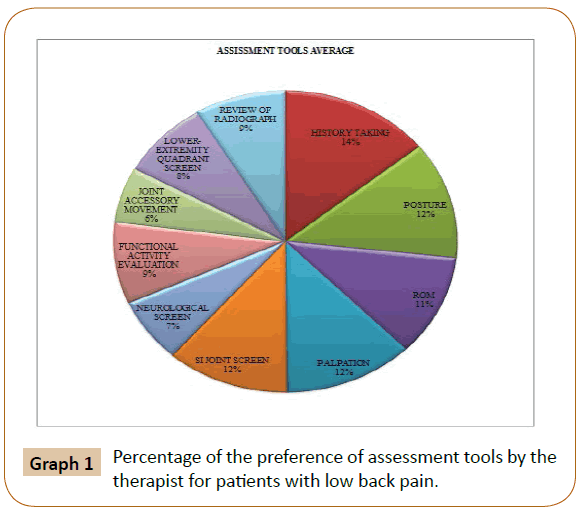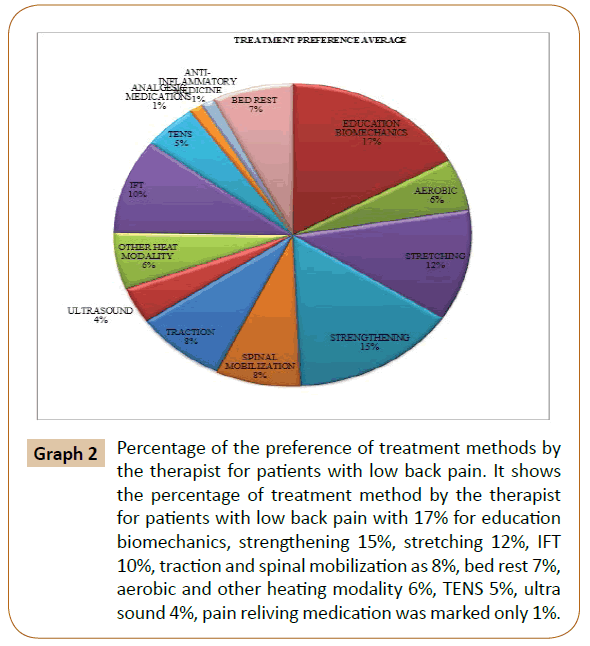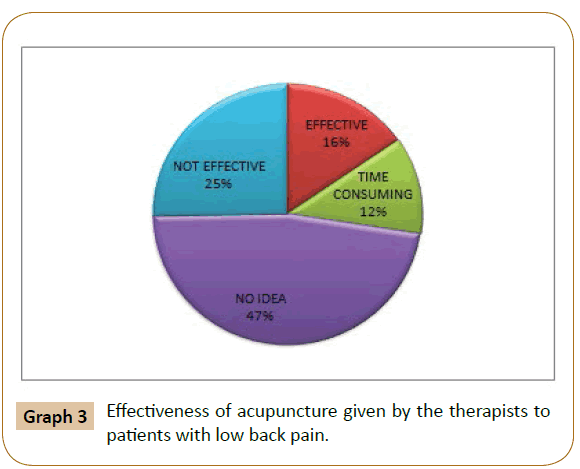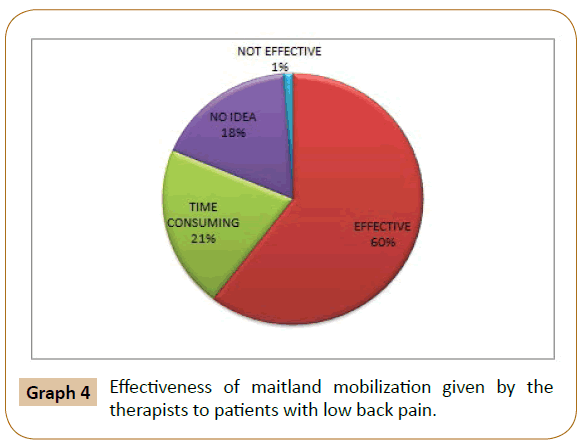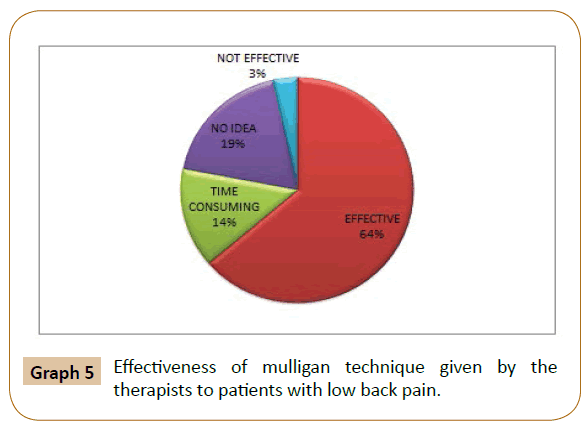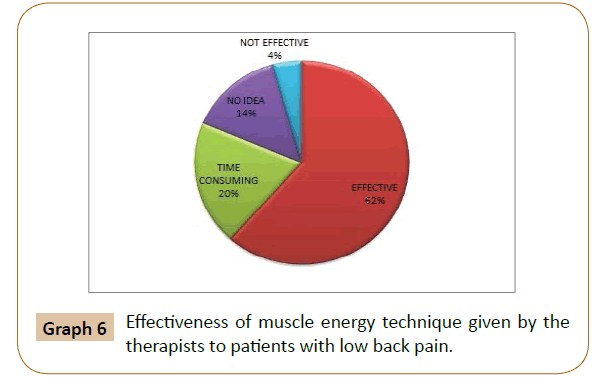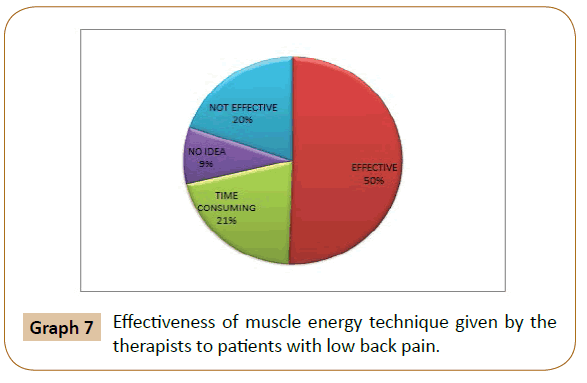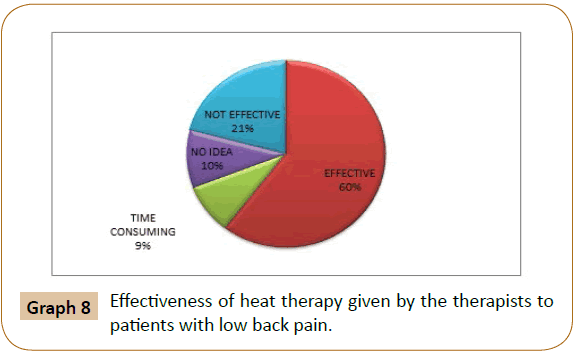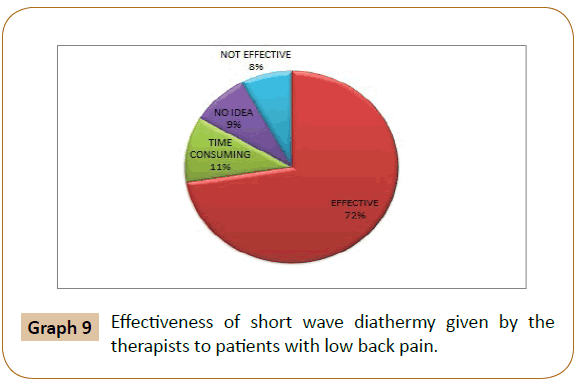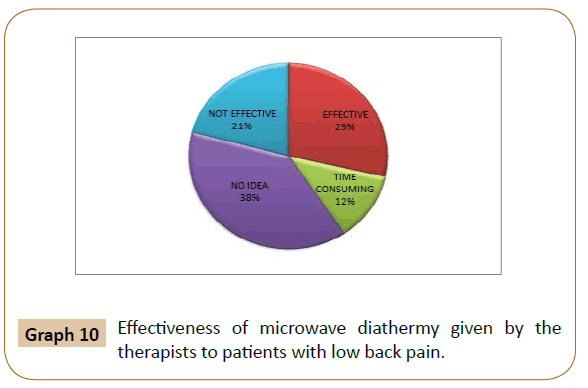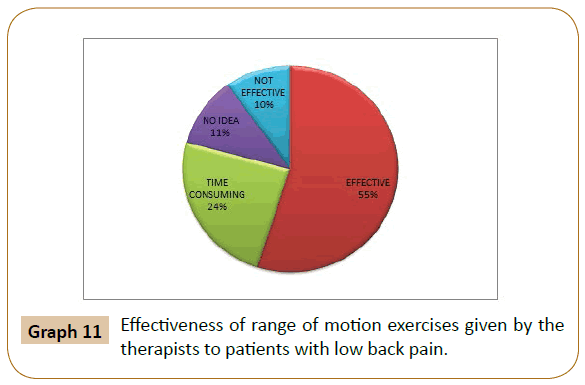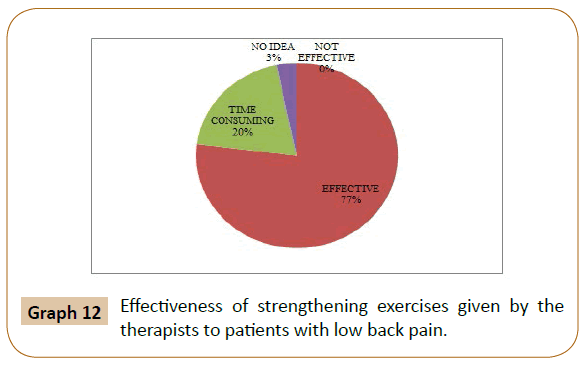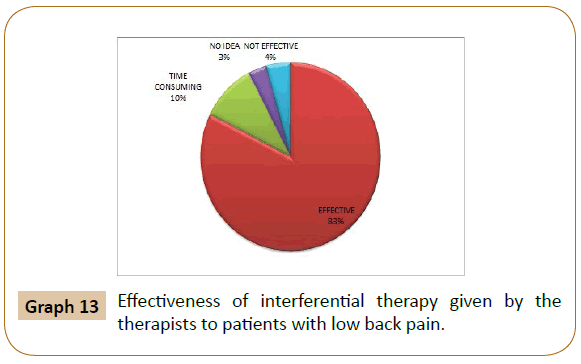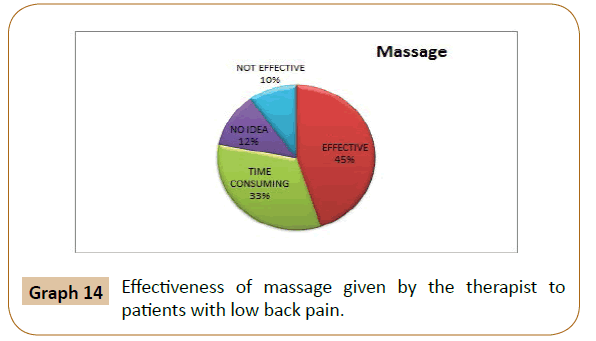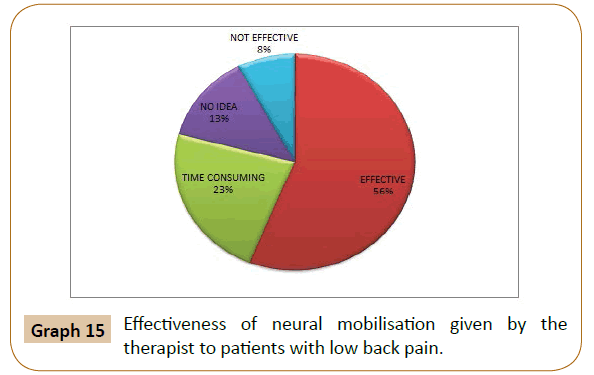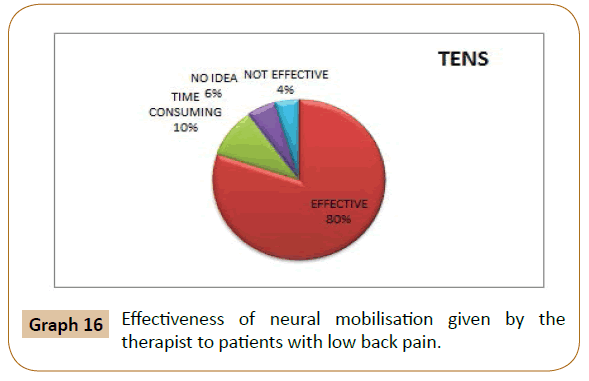Managing Low Back Pain: Attitudes and Treatment Preferences of Physical Therapists in Chennai
Sankarganesh A*, Jibin Jacob and VPR Siva Kumar
SRM College of Physiotherapy, SRM University, Chennai, Tamil Nadu, India
- *Corresponding Author:
- Sankarganesh A
SRM College of Physiotherapy
SRM University, Chennai, Tamil Nadu
India
Tel: 04427417833
E-mail: sankarganesh.a@ktr.srmuniv.ac.in
Received date: November 02, 2017; Accepted date: November 07, 2017; Published date: November 21, 2017
Citation: Sankarganesh A, Jacob J, Siva Kumar VPR (2017) Managing Low Back Pain: Attitudes and Treatment Preferences of Physical Therapists in Chennai. J Physiother Res Vol. 1 No. 2:7
Abstract
Background: Physiotherapy is commonly used in the management of low back pain it will show how the therapist assesses and treat the low back pain condition in Chennai. One more focus of this project is to find out how much a therapist thinks the treatments is effective. Objective: To determine the Attitudes and Treatment Preferences of Physical Therapists in Chennai in Managing Low Back Pain. Study design: Non-experimental study. Subjects: 91 therapists were included in the study these therapists were from Chennai all of them were practicing therapist many therapists were excluded because they were not practicing now or not in Chennai. Intervention: 91 therapists were interested to join the survey and they replied to the questioner some by the online form others by the written forms. Outcome measure: The method of evaluation by the therapists and treatment by the therapist and effectiveness of various treatments. Results: Result have shown that result show that history taking was the most preferred thing for the assessment then based on history the assessment is totally dependent greater preference is given to the treatments like teaching the patients about the mistakes he have done, strengthening, stretching, and exercises, in modality IFT is most common treatment preferred by the therapist for low back pain. Conclusion: Treatment by the IFT, exercise and education of body mechanics is the most preferable treatment and history posture palpation is the best assessment given by the therapist.
Keywords
Low back pain; Assessment; Treatment; Physiotherapy
Introduction
Low back pain (LBP) is a major health problem in modern society. Though several risk factors have been identified (including occupational posture, depressive moods, obesity, body height and age), the causes of the onset of low back pain remain obscure and diagnosis difficult to make. Back pain is not a disease but a constellation of symptoms. In most cases, the origins remain unknown. Low back pain affects people of all ages, from children to the elderly, and is a very frequent reason for medical consultations. The 2010 Global Burden of Disease Study estimated that low back pain is among the top 10 diseases and injuries that account for the highest burden worldwide. It is difficult to estimate the incidence of low back pain as the incidence of first-ever episodes of low back pain is already high by early adulthood and symptoms tend to recur over time [1]. The lifetime prevalence of non-specific (common) low back pain is estimated at 60% to 70% in industrialized countries (one-year prevalence 15% to 45%, adult incidence 5% per year). The prevalence rate for children and adolescents is lower than that seen in adults but is rising. Prevalence increases and peaks between the ages of 35 and 55. As the world population ages, low back pain will increase substantially due to the deterioration of bone. Low Back Pain prevails with work of the patients, physical condition of the patient, age and female preponderance [2]. Low socioeconomic status, poor education, previous history of Low Back Pain, physical factors such as lifting heavy loads, repetitive job, prolonged static posture and awkward posture, psychosocial factors such as anxiety, depression, job dissatisfaction, lack of job control and mental stress, working hours and obesity, muscle spasm have been found to be associated with Low Back Pain. Low back pain is a leading cause of disability [3]. It occurs in similar proportions in all cultures, interferes with quality of life and work performance, and is the most common reason for medical consultations. Few cases of back pain are due to specific causes; most cases are nonspecific. Diagnosis of the condition is very important because proper assessment leads the better management [4]. This study also tells about the Evaluation by different therapist how they treat for a specific condition. The physical therapist’s evaluation is an ongoing process that begins at the first contact with the patient, including when the physical therapist starts gathering information [5]. Evaluation is a necessary process because it determines the diagnosis and prognosis of the condition however these things may change the treatment given by them. Method of evaluation was asked from the therapist to find out which is the most followed method by physical therapist. Treatment preference is the important component for the treatment of low back pain on the aspect of wellbeing of the patient. The goals of physical therapy are to decrease back pain, increase function, and teach the patient a maintenance program to prevent future back problems. Passive physical therapy (modalities), which includes things, has done to the patient, such as heat application, ice packs, electrical modalities etc. Acutely, the physical therapist focuses on decreasing pain with passive physical therapy (modalities). These therapies are considered passive because they are done to the patient. For example, a heating pad may be applied to warm up the muscles prior to doing exercising and stretching, and an ice pack may be used afterward to sooth the muscles and soft tissues. Active physical therapy, which focuses on specific exercises, stretching. In addition to passive therapies, active physical therapy (exercise) is also necessary to rehabilitate. Stretching For most low back pain treatments, active exercise is the focus of the physical therapy program. Some groups of therapist don’t prefer modalities and treat with only active method. Therapist were also asked about other treatments used by other professionals to know the interest for new methods of treatments like acupuncture most of them have no idea, other said not effective, then effective and time consuming. This shoes most of them prefer the treatment which they feel related to their profession [6-9].
There is little information about how the therapist manages the Low Back Pain in general [10-12]. This study aims at describing the common assessment and treatment preference of physiotherapist for Low Back Pain on the basis of studies in Chennai population.
A questionnaire format has proved successful in previous studies of physiotherapy management of back pain and a similar structure was adopted for this study [13-16]. The questionnaire was divided into two sections. The first section included chronic low back, Acute-recurrent low back pain, acute low back pain and sciatica assessment and treatment by physiotherapists. The second section asked the effectiveness of various treatments by physiotherapists [17]. So to make the society more aware of different assessment and management by the therapist in India, This study was done [18].
Methodology
Study Design: Non-experimental. Study Type: Survey study. Study Setting: Hospitals and clinics in and around Chennai. Sample Method: Convenient sampling. Sample Size: 91.
Inclusion criteria of the study are as follows
• Those who willing for study,
• Qualified Physiotherapist with Bachelor of Physiotherapy education,
• Therapist treating low back pain patients.
Exclusion criteria of the study are as follows
• Therapist who left the profession,
• Those that is not willing for study.
Outcome measures of the study are as follows
Questionnaire to assess the therapist evaluation and treatment methods.
Procedure
91 Therapists from Chennai were conveniently selected from Chennai and were explained about the purpose of the study. Consent form was taken from the therapists who were willing to participate. Questionnaire will be given to the therapist and they were asked to fill the questionnaire accordingly. The Questionnaire contains three case scenarios and the therapist will be asked ways of assessing and treating it, the therapists were asked to mark their appropriate tool for evaluating and treating and then the survey was summed up, as well as the effectiveness of various treatment methods.
Results and Discussion
The majority of patients seeking treatment for LBP were relatively young (20-40 years), with most of them having chronic complains (Tables 1-3; Graphs 1-3). Management strategies for acute to chronic LBP did not appear to differ, but this question was not directly addressed in our questionnaire. According to the European guidelines management of acute and chronic back pain should be different and it also focused in evidence based practice followed by the therapists (Graphs 4-16).
| Assessment Tools | Chronic low back pain | Acute-recurrent low back pain | Acute low back pain and sciatica |
|---|---|---|---|
| History Taking | 86=14% | 83=14% | 80=13% |
| Posture | 76=13% | 81=14% | 74=12% |
| Rom | 66=11% | 68=11% | 71=12% |
| Palpation | 74=12% | 68=11% | 57=9% |
| SI Joint Screen | 70=12% | 57=10% | 58=10% |
| Neurological Screen | 42 =7 % | 42=7% | 73=12% |
| Functional Activity Evaluation | 53=9% | 64=11% | 54=9% |
| Joint Accessory Movement | 36=6% | 34=6% | 34=6% |
| Lower-Extremity Quadrant Screen | 51=8% | 39=7% | 44=7% |
| Review of Radiograph | 52=9% | 59=10% | 64=11% |
Table 1: Percentage of the preference of assessment tools by the therapist for patients with low back pain. This table shows that the first and most preferred assessment tool was History taking with 14%for chronic and acute recurrent Low back pain, and about 13%for acute low back pain and sciatica. It is followed by Posture assessment with about 14%.
| Treatment Preference | Chronic low back pain | Acute-recurrent low back pain | Acute low back pain and sciatica |
|---|---|---|---|
| Education Biomechanics | 83=17% | 84=17% | 71=14% |
| Aerobic | 27=5% | 25=5% | 16=3% |
| Stretching | 59=12% | 58=11% | 43=9% |
| Strengthening | 74=15% | 89=17% | 58=12% |
| Spinal Mobilization | 38=8% | 42=8% | 36=7% |
| Traction | 41=8% | 39=8% | 68=14% |
| Ultrasound | 19=4% | 13=3% | 11=2% |
| Other Heat Modality | 30=6% | 29=6% | 28=6% |
| IFT | 50=10% | 57=11% | 56=11% |
| TENS | 24=5% | 33=6% | 32=7% |
| Analgesic Medications | 6=1% | 8=2% | 10=2% |
| Anti-Inflammatory Medicine | 6=1% | 4=1% | 9=2% |
| Bed Rest | 28=6% | 53=11% | |
Table 2 Percentage of the preference of treatment methods by the therapist. For patients with low back pain. In the table shows that the first and most preferred treatment method was education 17% biomechanics with 14% for chronic and acute recurrent Low back pain, and about 14% for acute low back pain and sciatica and strengthening exercises with 17% for acute recurrent low back pain. It is followed by traction with about 14% for acute low back pain and sciatica.
| A | M | MET | MU | C | H | SWD | MWD | ROM | S | IFT | M | N | TENS | |
|---|---|---|---|---|---|---|---|---|---|---|---|---|---|---|
| Effective | 15 | 60 | 62 | 64 | 51 | 60 | 73 | 29 | 55 | 77 | 82 | 45 | 56 | 80 |
| Time Consuming | 12 | 21 | 20 | 14 | 21 | 9 | 11 | 12 | 24 | 20 | 10 | 33 | 23 | 10 |
| No Idea | 47 | 18 | 14 | 19 | 9 | 10 | 9 | 38 | 11 | 3 | 3 | 12 | 13 | 5 |
| Not Effective | 25 | 1 | 4 | 3 | 20 | 21 | 8 | 21 | 10 | 0 | 4 | 10 | 8 | 4 |
Table 3: Effectiveness of various treatments methods given by the therapists to patients with lowback pain. A-Acupuncture, M-Maitland, MU-Mulligan, C-Cryotherapy, H-Heat Therapy, S-Strengthening, M-Massage, N-Neural mobilization, SWD-Short Wave Diathermy, MWD-Micro Wave Diathermy, IFT-Interferential Therapy, MET-Muscle Energy Technique, ROM-Range of Movement, TENS-Transcutaneous Electrical Nerve Stimulation.
Graph 2: Percentage of the preference of treatment methods by the therapist for patients with low back pain. It shows the percentage of treatment method by the therapist for patients with low back pain with 17% for education biomechanics, strengthening 15%, stretching 12%, IFT 10%, traction and spinal mobilization as 8%, bed rest 7%, aerobic and other heating modality 6%, TENS 5%, ultra sound 4%, pain reliving medication was marked only 1%.
Graph 3: Effectiveness of acupuncture given by the therapists to patients with low back pain.
This survey was entirely based on therapists’ perceptions and opinions. Lack of published information on Low Back Pain management in Chennai was the primary reason for undertaking this survey. This survey focused on assessment and treatment preference by the physiotherapist for three particular cases such as chronic low back pain, Acute-recurrent low back pain, acute low back pain and sciatica and the effectiveness of various treatments for the low back pain. Regarding the concept of Assessment methods therapists were asked to mark their preferable assessment tool in the questionnaire. Blank lines were given to them to fill any extra things they want to add in assessment.
Assessment tool: The survey showed that the therapist prefer History taking as the assessment tool (14%), the next assessment tool that gained its importance is posture(12%) assessment whereas palpation (12%) and SI joint screening were done from (11-12%) review of radio graph was done in all the three cases from (9-11%) History taking was the preferred assessment tool in all three cases where as posture assessment is given equal importance as history taking in the cases of acute recurrent low back pain and then acute low back pain and sciatica neurological screening is given an important place next to history taking.
In Chronic low back pain patients history taking (14%), posture (13%), palpation, sacroiliac joint screen (12%) and range of motion (11%) were given the prime importance whereas review of radio graph (9%) functional activity evaluation (9%) are likely done by more therapist (9%), neurological screening (7%) and lower extremity quadrant screening (8%) and joint accessory movement (6%) are the least preferred assessment tools used by the therapist.
These table shows 82% of the therapist told Interferential therapy to be effective and 80% scored for Transcutaneous Electrical Nerve Stimulation, Strengthening was told effective by many therapists 77% and Short Wave Diathermy scored 73% Manual therapies are voted as effective next with Maitland 60%, Mulligan 64% and Muscle Energy Technique 62%, Heat therapy was told effective by 60% whereas Cryotherapy by 51%. About 56% of therapist told Neural mobilization to be effective and 55% told Range of movements to be effective, Massage was scored by 45% of therapist and 29% scored for Microwave Diathermy, and only 19% told Acupuncture effective in subjects with Low Back Pain. Although history taking and posture evaluation are given its importance neurological screening and assessor movement evaluation has lost its importance according to the survey which is alarming. For a proper assessment accessory movement evaluation functional activity evaluation and neurological screening has also to be done in detail for planning a better treatment protocol.
Among the acute recurrent low back pain cases apart from history taking and posture assessment (14%) range of motion (11%), palpation (11%), and functional activity evaluation (9%) were given important (11%) and neurological and joint accessory movement evaluation lower extremity quadrant screening were given the least importance (6-7%).
In acute recurrent low back pain all the assessment tools expect neurological screening and joint accessory movement evaluation lower extremity quadrant screening was done with almost care for properly evaluating the patient and it’s an essential point to address that those three assessment tools also should be given importance for properly evaluating the patients.
In acute low back pain and sciatica all the assessment tools, history taking (13%), posture (12%), range of motion (12%), palpation (12%) were given the first preference (12%) only in these cases neurological screening is given more importance (12%) than the other two groups (7%). Sacroiliac joint screening and review of radiograph were given the next preference (10%) palpation was done in less percentage in this case (9%) then the other two cases (11-12%). Except for the palpation, joint accessory movement and lower extremity screening other assessment tools were given due importance over the assessment of acute low back pain and sciatica.
Treatment methods: In treatment aspect education of biomechanics and strengthening (17%) were the most preferred methods and IFT (10%) and traction (8%) were also preferred by therapist mostly in the treatment of low Back pain. Chronic low back pain educating body mechanics (17%), strengthening (15%), stretching (12%), IFT (10%) was mostly preferred by the therapists. Other than this spinal mobilization (8%) traction (8%), bed rest (7%), aerobic exercise, heat modality (6%) were preferred by the therapist medicines were the lowest (1%) Among the modalities IFT gains (10%) then TENS (5%) ultrasound (4%), traction and other heat modalities its it is on a positive side education biomechanics stretching and strengthening were give more preference than the pain reliving modality spinal mobilization has to be encouraged as lot of research are prevailing and these techniques were used worldwide.
In case of acute recurrent low back pain educating biomechanics (17%) and strengthening (17%) were mostly preferred other than this IFT (11%) and stretching 11% Spinal mobilization and traction was preferred the next 8% modalities and aerobics were given the least importance. Now a day’s most of the researches documented that there is an effectiveness of spinal mobilization techniques so that the awareness on Spinal mobilization can be increased.
In case of acute low back pain and sciatica, traction and educating biomechanics were given more importance (14%) followed by strengthening and IFT (11%), bed rest is also advised more (11%) than the other two groups (6-7%) of stretching, TENS are given the next preference (7-9%) Traction and bed rest were given more importance in radiating pain than in acute and chronic low back pain.
Overall Results give us an idea that how the therapist were assessing the condition and it will be useful for future research and it will be helpful for new therapists to have an idea how the assessment is done. For all the cases history taking is the most common method used by the therapist then posture, palpation, SI joint screen, then ROM, other methods it shown us that prime focus of the therapist were on the following assessment tools. So it gives a good idea that these methods are mostly preferred.
Educating body mechanics was mostly used treatment in all the three cases. It is important to teach the patient about the mistake done by them, strengthening, stretching, IFT, traction was the mostly used therapy in all the three cases. Pain reliving medication (Analgesics) was the lowest therapy which is used by the therapist proves that medicine is not the treatment preferred by of the therapist. Bed rest is only advice given by the therapist in acute low back pain with sciatica.
To be on a positive part therapist recommend less use of modality and relaying more on exercises which is important and produce long term results. These reviews are supported by many researches and this study also repeated in many countries which also give us similar results.
For acute recurrent and chronic low back pain, the recommendations are educating bio mechanics strengthening and stretching exercises and bed rest preferences was low. For acute with sciatica low back pain, the conservative treatments recommended are: bed rest preference is high educating bio mechanics, strengthening and stretching exercises were always rated high. Results shown us an idea that how the therapist were treating the condition and it will be useful for future research and it will be helpful for new therapists to have an idea how the treatments are done. In regards to treatment preferences, Chennai therapists reported that they mainly used electrotherapy with exercises in the management of LBP. Only 91 therapists were given reply. The reason for this may be they didn’t want to reveal their methods of treatments.
Conclusion
This study focused on how the therapist approaches the patients with low back pain. In assessment mostly therapist prefer history taking, posture, palpation, ROM, SI joint screening. Treatments like educating body mechanics, strengthening, stretching, traction, interferential therapy, trance coetaneous electrical nerve stimulation. Is most commonly used treatment for low back pain. These methods can be said mostly followed by the therapist.
Limitations and Recommendations
Limitations: Sample size can be increased. Only Chennai area taken for the study.
Recommendations
Further studies can be done in larger sample size. In future studies many states or whole country can be taken for the study. More treatment and assessment method can be added. Duration of study can be increased.
References
- Battié MC, Cherkin DC, Dunn R, Ciol MA, Wheeler KJ (1994) concluded that Managing Low Back Pain: Attitudes and Treatment Preferences of Physical Therapists. Phys Ther 74: 219-226.
- Daniel C, Frederick A, Alfred O (1998) Managing Low Back Pain-A Comparison of the Beliefs and Behaviors of Family Physicians and Chiropractors. West J Med 149: 475-480.
- Linda C, Bombardier C (2001) Physical therapy management of low back pain: An exploratory survey of therapist approaches. Physic Ther 81: 1018-1028.
- Jette AM, Smith K, Haley SM, Davis KD (1994) Physical Therapy Episodes of Care for Patients with low back pain. Phys Ther 71: 273-280.
- Riihimki H (1991) Low back pain: its origin and risk factors. Scand J Work Environ Health 17: 81-90.
- (1987) Scientific approach to the assessment and management of activity-related spinal disorders- a monograph for physicians: report of the Quebec Task Force on Spinal Disorders. Spine 12: 1-59.
- Deyo RA, Cherkin D, Conrad D, Volinn E (1991) Low back pain and the public health. Annu Rev Public Health 12: 141-156.
- Jette AM, Davis KD (1991) A comparison of hospital-based and private outpatient physical therapy practices. Phys Ther 71: 366-375.
- Cherkin DC, MacCornack FA, Berg AO (1993) Managing low back pain: a comparison of the beliefs and behaviours of family medicine physicians and chiropractors. West J Med 49: 475-480.
- Mathew AC, Safar RS, Anithadevi TS, Banu MS, Shankar LSR, et al. (2013) How Are Physical Therapist Evaluations 2 Performed, and What Tests and Measures Do 3 Physical Therapists Use? Int J Med Public Health 3: 342-346.
- Airaksinen O, Brox JI, Cedraschi C, Hildebrandt J, Klaber-Moffett J (2006) European guidelines for the management of chronic nonspecific low back pain. Eur Spine J 2: 192-300.
- Karayannis NV, Jull GA, Hodges PW (2012) Physiotherapy movement based classification approaches to low back pain: comparison of subgroups through review and developer/expert survey. BMC Musculoskelet Disord 13: 24.
- Cherkin DC, Sherman KJ, Deyo RA, Shekelle PG (2003) A Review of the Evidence for the Effectiveness, Safety, and Cost of Acupuncture, Massage Therapy, and Spinal Manipulation for Back. Ann Intern Med 138: 898-906.
- Savigny P, Kuntze S, Watson P, Underwood M, Ritchie G, et al. (2009) Low back pain: early management of persistent non-specific low back pain. Royal College of General Practitioners.
- French SD, Cameron M, Walker BF, Reggars JW, Esterman AJ (2010) Superficial heat or cold for low back pain (Review). Cochrane Database Syst Rev 1: CD004750.
- Aure OF, Nilsen JH, Vasseljen O (2011) Manual Therapy and Exercise Therapy in Patients with Chronic Low Back Pain. Spine 28: 525-531.
- Mokdad AH, Mensah GA, Posner SF (2005) When Chronic Conditions Become Acute: Prevention and Control of Chronic Diseases and Adverse Health Outcomes during Natural Disasters. Prev Chronic Dis 2: A04.
- Ferreira GD (2011) Prevalence and associated factors of back pain in adults from southern Brazil: a population-based study. Brazilian J Phys Ther 5: 166.
Open Access Journals
- Aquaculture & Veterinary Science
- Chemistry & Chemical Sciences
- Clinical Sciences
- Engineering
- General Science
- Genetics & Molecular Biology
- Health Care & Nursing
- Immunology & Microbiology
- Materials Science
- Mathematics & Physics
- Medical Sciences
- Neurology & Psychiatry
- Oncology & Cancer Science
- Pharmaceutical Sciences
